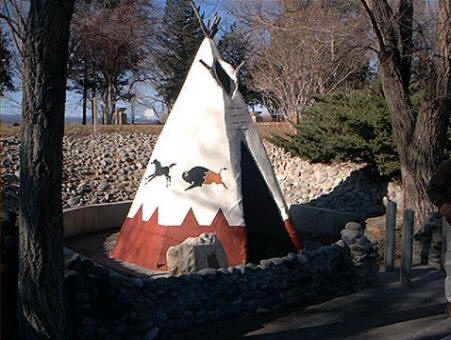The DAR erected the tepee over the spring on Chipeta and Ouray’s homestead. It was restored in 2009 by the Uncompahgre Valley Chapter, NSDAR. The restoration ceremony, dubbed the “Chipeta Spring Ceremony,” was held November 21, 2009. The tepee is located in Chipeta Park at the Ute Indian Museum in Montrose, Colorado.
“Chief Ouray and his wife Chipeta were respected, peaceful leaders of the Uncompahgre Valley Ute Tribe, willing to negotiate to keep peace with the invading white settlers. Chipeta died on August 17, 1924, of chronic gastritis and was buried in a shallow grave on the Utah reservation. Her body was later removed to Montrose where the local chapter of the DAR purchased land from Ouray’s original homestead and erected a tomb for “Queen” Chipeta. Hundreds of locals attended her services and her pallbearers were some of the town’s leading citizens.” (Marilyn Cox, Montrose Daily Press, April 8, 2008)
Uncompahgre Valley Chapter Dedicates Bronze Plaque
The dedication took place in front of a concrete tepee, which rests over a natural spring, and will replace a painted inscription inside the tepee’s walls with a new solid bronze marker permanently mounted to a large boulder.
The local DAR chapter, which was re-chartered in 1993 and re-named Uncompahgre Valley Chapter, felt the original marker should be replaced due to its age and concern that it could be potentially painted over. The idea of a more permanent fixture appealed to the members who desired to preserve this historic land for future generations and forever honor the Ute Chief Ouray and his peace-loving wife, Chipeta. Several chapter members spent four years gaining approval for the new bronze marker from the national office in Washington, D.C.
The inscription on the commemorative plaque reads:
In Memory of Chipeta, Wife of Chief Ouray. Tepee erected over Ouray and Chipeta’s Spring 1924 by the DAR. Permanent Marker placed by Uncompahgre Valley Chapter, NSDAR 2009.
In 1945, the land purchased by the original DAR chapter was deeded to the Colorado Historical Society. This was the beginning of the Ute Indian Museum, which now serves as a central cultural base for Ute Indians throughout the southwest and attracts thousands of tourists each year.
The plaque dedication was one part of a day-long National American Indian Heritage Month celebration, which included several other museum events and presentations sponsored by the Ute Indian Museum.
During the gold rush in the San Juan Mountains in the late 1800s, Chief Ouray and his wife Chipeta traveled to Washington, D.C., to testify at land hearings. Treaty negotiations stalled after Chief Ouray died in August 1880, and by September 1881 the Ute Indians had lost the battle and were sent to the desert of eastern Utah, where Chipeta died in 1924.
The following year, her body was removed and returned to Montrose, where the local DAR chapter of the DAR purchased 8.65 acres from Ouray’s original homestead and erected a tomb for “Queen” Chipeta. This is now the site of the Ute Indian Museum and memorial park. Chipeta’s brother John McCook returned to Montrose with her body and at his death was laid to rest beside her, his grave marked by a white cross.
